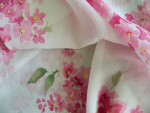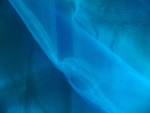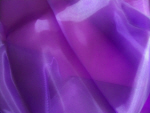|
[?]Subscribe To This Site
|
Sheer Fabric – Transparent Elegance and Luxury
Sheer fabric is the essence of elegance, class, and femininity. Sheer fabric adds something extra to any design, and makes the design look special. These fabrics are made from a variety of fibers and fiber blends.
Sheers are classified as crisp, soft and semi-crisp. The crisp sheers include: organdy, organza, dotted Swiss, marquisette, and handkerchief linen. The soft sheers include: chiffon, georgette, and crepe chiffon. The semi-crisp sheers include: voile, lawn, dimity, shirting, batiste, eyelash voile, gauze, rayon challis, and Viyella. Crisp sheers are the easiest to sew and soft sheers are the most difficult to sew. Semi-crisp sheers may or may not be difficult to sew; it depends upon the looseness of the weave.



Fabric Characteristics:
• These fabrics show the seams, hems, and facings on the outside of the garment due to the sheerness of the fabric • Light colors are more transparent than dark colors • Can be made opaque by adding a lining, underlining or multiple layers of the sheer fabric • Many are fragile • Slippage can occur on closely fitted garments • Some ravel badly • Some are very slippery • Some have a sheen or satin weave and should be treated like napped fabrics • Some can sag when sewn if attached to firmly woven lining fabrics • Skipped stitches and puckered seams can be a problem • Some can be damaged by the presser foot, feed dogs and needles that are too large or defective • A lower iron setting is required
Working With These Fabrics Requires:
• Sewing machine needles recommended are sizes 60/8-70/10 sharps, universals and stretch needles • Hand sewing needles recommended are sizes 8-10 • Sewing machine settings recommended are a stitch length of 1.25-2 mm • Sewing machine feet should be the wide straight stitch or roller foot • Thread recommended is all-purpose cotton, polyester and cotton/polyester blend • Marking tools recommended are all types, except wax • Tools and equipment recommended are sharp scissors, sharp shears, rotary cutter and mat, pins, fabric weights, and fabric stabilizers • Seams recommended are narrow French hems, machine rolled, and serged to name a few • Hems recommended are very narrow machine-rolled, wide double fold, and satin-stitched to name a few • Edge finishes recommended are self-fabric bindings, contrast bindings, bias bindings, ribbon bindings, bands, bias facings, tricot facings, lace facings to name a few • Closure recommended are buttons and machine or hand sewn buttonholes, buttons, loops, frogs, snaps, hooks and eyes, ties, and zippers • Interfacings, linings and underlinings should be used for modesty, color or design
These Fabrics Are Suitable For:
Sheers are suitable for clothing to add a touch of elegance, stockings, tights, dancewear, lingerie, parts of wedding gowns and other formal costumes, and home décor such as curtains.
For information about the notions, tools, and equipment required to complete a sewing project, click here to view the sewing notions home page For more information about this family of fabrics some great references are:
Claire Shaeffer’s Fabric Sewing Guide
For more interesting information about sheer fabric click here on Wikipedia.org
and click here on
ehow.com for information about how to line fabric that is sheer
To continue exploring information about fabrics follow the links below.
Silk Fabric
|




